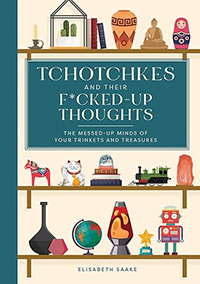Tchotchkes and Their F*cked-up Thoughts: The Messed-up Minds of Your Trinkets and Treasures by Elisabeth Saake; Illustrations by Shutterstock; Oakland, California: The Collective Book Studio © 2025; ISBN 9781685-556211; 119 pages; $15.95.

 LA MESA, California – Author Elisabeth Saake starts off her book with a description of what a tchotchke is. “A tchotchke (CHOTCH-kee) is a knickknack, collectible, or miscellaneous item that decorates (or clutters) your shelves. The term has long been a favorite among Jewish Americans and made its way into the quirky vernacular of New York City and beyond. Borrowed from Yiddish and of Slavic origin, the word tchotchke has a history as varied and colorful as the objects themselves. And, as we now know, these trinkets possess little minds that are just as f–ked up as yours ….”
LA MESA, California – Author Elisabeth Saake starts off her book with a description of what a tchotchke is. “A tchotchke (CHOTCH-kee) is a knickknack, collectible, or miscellaneous item that decorates (or clutters) your shelves. The term has long been a favorite among Jewish Americans and made its way into the quirky vernacular of New York City and beyond. Borrowed from Yiddish and of Slavic origin, the word tchotchke has a history as varied and colorful as the objects themselves. And, as we now know, these trinkets possess little minds that are just as f–ked up as yours ….”
The contents are divided into chapters labeled: Whimsical, Vintage and Collectibles, Cultural and Artisanal, Spiritual and Mystical, Functional and Decorative.
Saake challenges readers to explore their knickknacks. Are they charming décor, beloved heirlooms, or travel impulses? Many of these trinkets have tales so Saake dives into some of the common tchotchkes found on vacation and what they might say if they could talk.
In the Whimsical chapter, The Bobblehead Doll popped out at me as it can represent anyone depending on what event you are attending, such as a San Diego Padres Game or a San Diego Comic-Con Convention. The bobblehead shakes its head, acknowledging that the owner of the tchotchke is a genius, is brilliant, and all the answers are correct.
In the Vintage and Collectibles chapter, the Antique Teacup and Saucer Set struck me as either a family heirloom or something spotted at a thrift store. Saake gives it a British accent and says the teacup and saucer is demanding cucumber sandwiches. She calls the owner a daft arsebadger (one who has a painful bowel movement).
In the Cultural and Artisanal chapter, the Russian Nesting Doll impressed me as either a family heirloom from the “old country” or a vacation purchase. Saake says to imagine how it feels to be jam-packed with smaller versions of yourself, Big Olga picks fights with little Svetlana and middle-sized Elena fights with itsy-bitsy Katya.
In the Spiritual and Mystical chapter, the Menorah was the book’s only Jewish tchotchke. Saake gives the menorah the voice of an old zayde (grandfather) who calls its owner a schmuck for thinking it was a fancy candle holder. The care and handling of the menorah says to fill its branches with holy oil from trees grown on the Mount of Olives, just a day’s worth, and watch them burn for eight. Or cram in cheap candles from the store, that works too. Way to honor your ancestors, nudnik (nuisance).
In the Functional and Decorative chapter, the Handmade Quilt seemed to be something everyone gets as it is passed down from generation to generation. Saake suggests that if this quilt could talk, oh the stories it would tell from the precious child sleeping with it on cold nights, to being made into forts, to having to cover its eyes to avoid witnessing the “sweet child’s” new-found freedom in the college dorm.
After reading this short picture book, it had me wondering what my Statue of Liberty and Eiffel Tower tchotchkes would say to each other? I am a sucker for getting items on trips. I usually look for a hoodie as a souvenir as it turns into a conversation piece.
*
Cailin Acosta is the assistant editor of the San Diego Jewish World.